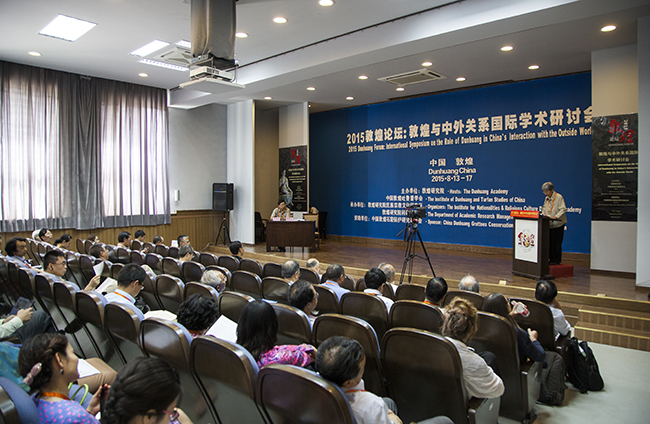Scholars gather to discuss frontiers of Dunhuang study

The 2015 Dunhuang Forum: “International Symposium on the Role of Dunhuang in China’s Interaction with the Outside World” opened on Aug. 14 in the Dunhuang Mogao Grottoes.
The 2015 Dunhuang Forum: “International Symposium on the Role of Dunhuang in China’s Interaction with the Outside World” opened on Aug. 14 in the Dunhuang Mogao Grottoes. More than 190 experts and scholars from China, Germany, Russia, France, Britain, Japan, South Korea, America and other countries gathered in Dunhuang and exchanged their views on the discipline.
Co-hosted by the Dunhuang Research Academy and the Institute of Dunhuang and Turfan Studies of China, the forum aims to provide a platform for experts from at home and abroad to explore academic issues, such as the part that Dunhuang research plays in China’s interactions with the external world, and the role of Dunhuang in the Silk Road as well as its part in boosting the cultural communication between the East and the West. In this way, mutual exchanges and reciprocal learning can be fostered.
Wang Xudong, director of the Dunhuang Research Academy, said during the opening ceremony that the painted sculpture, mural images and wealth of literature excavated in the Dunhuang grottoes are invaluable historical documents, which, through recording the politics, economy, religion and military affairs of China and the West, offer a testament to the history of interactions among various civilizations.
“It is the cultural profundity of both China and the West along the Silk Road that contributed to the prosperity and glory of the ancient Dunhuang culture,” Wang said. At present, the “One Belt, One Road” initiative that China has proposed not only creates a good opportunity for cultural exchanges between China and the world but also presents possibilities for renewed study of the ancient Silk Road.
The construction of the Silk Road and its development during the Han (206 BC-220 AD) and Tang (618-907) dynasties, which lasted from the 2nd Century BC to the 9th Century, largely stimulated Eastern-Western cultural communication and interaction between civilizations. Dunhuang, as a hub of the Silk Road, became the first major place for Eastern-Western cultural communication due to its unique geographical position. It is what makes the Dunhuang caves and the writings preserved in its grottoes eternal cultural and artistic treasures.
At the forum during the following two days, the attendees also discussed the connection of Dunhuang with both China and the world, such as the external factors of Dunhuang art, the three major religions that originated from foreign countries—Manichaeism, Nestorianism and Zoroastrianism—in the Tang Dynasty, and other issues concerning the history and culture of Dunhuang.
Feng Zhijun is a reporter at the Chinese Social Sciences Today.
